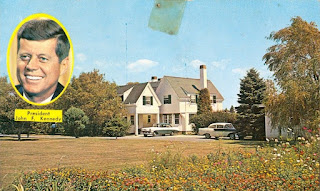
I recently bought this picture on ebay. It is of the cast and musicians of
Your Hit Parade, and appears to be from 1950 (the year the show came to television), or the start of 1951. (Neither singer Russell Arms, nor my mother, are pictured. My mother joined the cast of the program in late February of 1951; I believe Russell Arms joined the show's cast earlier the same month.)
Here are some of the people in the photograph:
To the right of the picture, in the foreground (see enlarged section, at left), are the primary singing stars of the program, from 1950 to 1952: Eileen Wilson, Snooky Lanson (wearing bow-tie), and Dorothy Collins. To the right of (and behind) Collins, seated on a stool, is orchestra leader Raymond Scott.
At left of center, in the foreground (see enlarged section, below), are dancers Dusty McCaffrey, Virginia Conwell, and Lenny Claret.
Behind McCaffrey, Conwell, and Claret are the “Hit Paraders,” the program’s choral group.
The first three female singers (left to right) are: Geri Beitzel, Rae Whitney and Marilyn Jackson; I do not know the name of the last singer in the row.

(According to Ray Charles, the
Hit Parade’s vocal arranger, Marilyn Jackson was probably a substitute Hit Parader during the week the photograph was taken; Jackson was a regular, at the time, on Perry Como's TV show, as one of the singers in Charles's vocal group, "The Ray Charles Singers." For much of the 1950s, Ray Charles—often referred to as the
other Ray Charles—served as the vocal arranger for
Your Hit Parade. At the same time, he worked each week on Perry Como’s TV show—work which included arranging the vocals for, and overseeing, his Ray Charles Singers. All told, The Ray Charles Singers were, for decades, an integral part of Perry Como’s television shows, recordings, and live appearances.)
Behind the female Hit Paraders, in the photo, are the male Hit Paraders, at the time. They are (left to right): Marshall Hall, John Smedberg, Gene Lowell (with moustache), Ed Lindstrom, Artie Malvin, and three singers in costume: Hubie Hendrie, an unidentified singer (partially obscured), and Jimmy Pollack.
In addition: the drummer in the photo is Bunny Shawker. The bass player (far left) is Jack Lesberg.
 In 2011, on my "Radio Once More" program, I interviewed historian (and Research Associate at the Smithsonian Institution Archives) Marcel Chotkowski LaFollette, Ph.D.
In 2011, on my "Radio Once More" program, I interviewed historian (and Research Associate at the Smithsonian Institution Archives) Marcel Chotkowski LaFollette, Ph.D.



originalthumbnail.jpg)

































